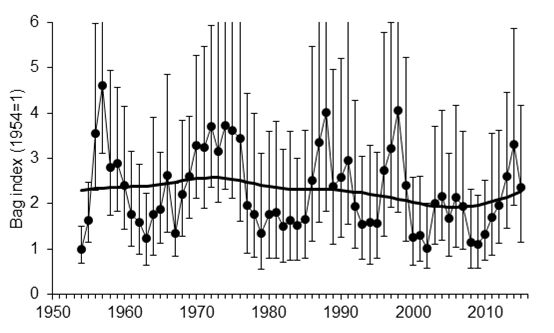IN response to the publication of the Watson and Wilson (2018) paper on mountain hare populations, David Noble, Chairman (Scotland) of GWCT, said:
“We are delighted that the authors of this paper recognise that that mountain hares thrive on heather moorland managed for red grouse, that their numbers can increase quickly in such areas and that the long-term threat to their population is from landscape scale habitat change, especially coniferous tree planting.
“GWCT’s studies of where mountain hares are living in Scotland agree that most losses are at the edge of their range, where heather moorland has been changed to forest and farmland 1. But data gathered by the GWCT over the same period as this study does not suggest such a decline in hare numbers on our remaining grouse moors2, and that our counts in recent years have found robust hare populations close to where this paper appears to be reporting very few. Now this paper is published we look forward to reviewing it, especially how the counts were made, because assessing hare numbers accurately is challenging.
“It is also important the grouse moor community take on the challenge of assessing hare numbers themselves and does not ignore public concerns about the culling of this charismatic species. What is required and should parallel Scottish Ministers’ review of grouse moor management in 2019, is a coordinated approach with counting and management of mountain hares at regional level to safeguard against the possibility of any threat to local populations.”
- Distribution of mountain hares (Lepus timidus) in Scotland: results from a questionnaire. Patton, V. et al. (2010). Mammal Review 40, 313-32
- Mountain hare index from National Gamebag Census data, 1954-2015. The thick line is the underlying long-term trend. Error bars represent 95% confidence intervals.

Notes to editors
The Game & Wildlife Conservation Trust – providing research-led conservation for a thriving countryside. The GWCT is an independent wildlife conservation charity which has carried out scientific research into Britain’s game and wildlife since the 1930s. We advise farmers and landowners on improving wildlife habitats. We employ more than 60 post-doctoral scientists and other research staff with expertise in areas such as birds, insects, mammals, farming, fish and statistics. We undertake our own research as well as projects funded by contract and grant-aid from government and private bodies.
For information, contact:
Eleanor Williams
Telephone: 07592 025476
Email: press@gwct.org.uk